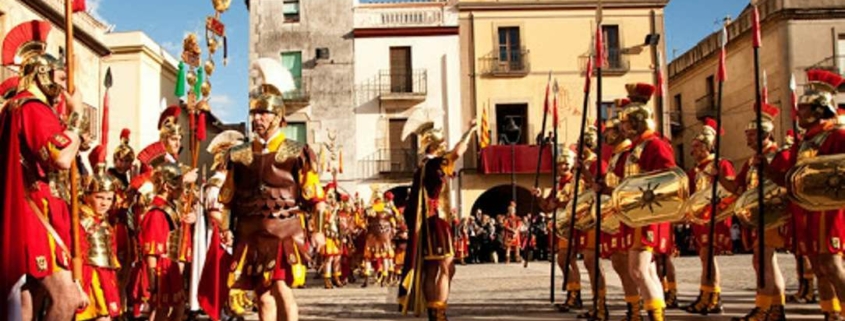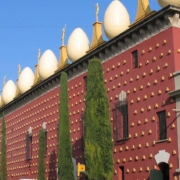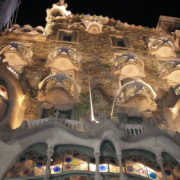Easter Processions in Catalonia, Northern Spain
Easter procession in Girona
Easter processions have been a tradition in Girona ever since 1566. Experience Easter in Catalunya, Northern Spain with a Luxury Food & Wine Tour of the Costa Brava. Commencing near to the cathedral on Good Friday at 10pm it continues throughout the Old Town. Suffering and Death, accompanied with disharmonic music, have something to them that reminds the spectator of Verdi’s The Power of Fate. All penitents are traditionally clad in hooded cloaks with small peepholes for the eyes. Thus, nobody can be recognized and anonymity is guaranteed since penance is a private affair. There are a number of different fraternities and they can be told apart by the different colours of their cloaks. Some pennants are also carrying big crosses made of wood and richly adorned altars. Standing on the latter, there are life-size figurines of Saints and different sceneries re-enacting the Sufferings of Christ, which are called Pasos procesionales. Chief Executive or factory worker, this day, it makes no difference. There is mystic, there is religion and there is mere happiness. Being part of a fraternity (confraries) is usually inherited and considered a great honour. In Girona, the Easter Processions have little in common with the dark and gloomy procession they used to be in the Middle Ages; they are indeed more of a Baroque folk festival. In splendid colours and adorned with flowers, the beautifully carved Madonna has a special appearance as a light in the darkness. She is a virgin, a goddess, a heavenly beautiful creature and wherever she goes, she is met by rejoicing and enthusiasm. In a flurry of flashbulbs, she is the queen of Easter Night, surrounded by intoxicating whiffs of olibanum. Paso de Christo passes her by, swaying, his face a mask of suffering patience. The mystic scenery, the beautiful Old Town of Girona – it truly is a feast for the senses. All the little cafes are open far into the night and all pubs and restaurants will not close until the early morning. Friends and acquaintances, all are together and everyone is in high spirits.
Dance of Dead in Verges
Verges is quite different. The tiny, medieval town between Figueres and La Bisbal is host to the Dance of Dead on Maundy Thursday, at midnight. The event is a rather interesting relic of medieval liturgies and each year, more and more spectators come to take part. It all begins at 10pm in the market place, where the Sufferings of Christ are re-enacted. Then, at midnight, people gather for a procession through the village, lead by people dressed as skeletons, the procession moves through Vergez’ narrow, winding alleys. This somewhat bizarre spectacle, accompanied by drums, is known to be one of the oldest manifestations of Christian art. Candles, with wax dripping from them, mark the way. The dull sound of drums, the eerie rattling of chains, the sound of whip lashes – and the many, many spectators are what makes the spectacle worth a visit. The town’s medieval atmosphere adds to the dramatic air. Just as in Girona, all pubs are open all night long too. The town is vibrant with anticipation.
The Sufferings of Christ in Sant Climent Sescebes
In Sant Climent Sescebes, a town at the Pyrenees’ foothills, the Sufferings of Christ are re-enacted on several evening during the Paschal Week. Love. Sacrifice. Forgiveness. Hope! What sounds like a Hollywood movie really is deeply religious. “La Passio” in Sant Climent Sescebes is known for the village’s inhabitants taking the lead part. Ever since the 1970’s they have put Jesus’ story on stage. How he came to Jerusalem, how he had the Last Supper, how he was betrayed, condemned and crucified and how he was resurrected. Those living pictures appear like historical paintings as they tell the stories of the New Testament, accompanied by music. It is a highly emotional way to remind people of why we still celebrate Easter, even today. On Easter Sunday, there is a Jewish Market in the winding alleys of Sant Climent Sescebes and there is food and drink galore.
The last days of Jesus life in Castelló d’Empúries
The last days of Jesus’ life were full of emotional scenes, especially on his way to the cross. Generations of artists have been inspired by the story of the New Testament and have, as a consequence, left us many masterpieces. Some of them can be found around the basilica Santa Maria de la Candelera in Castelló d’Empúries – especially stone sculptures. This Easter the stones come alive: under torchlight the Roman soldiers gather, together with the disciples, Maria and Jesus and suddenly the wheel of history has been turned back; we find ourselves in the first century, a few hours before God’s son on Earth will die.
Generally speaking, Easter Sunday is a family holiday in Spain. Everybody meets up for a feast. Happy Easter!
It´s not just Catalunya where the Easter Processions are celebrated- this period is also a wonderful time to visit Andalusia in the South of Spain-huge religious celebrations take place around the easter week, namely Semana Santa , why not let us Customize a Private Tour for you around Andalusia so you can enjoy the festivities Spanish style (i.e plenty of eating and drinking!)



